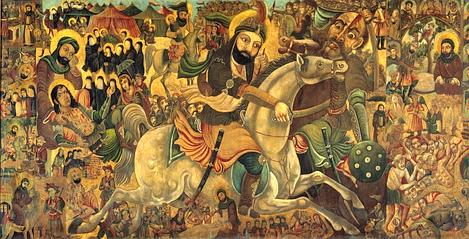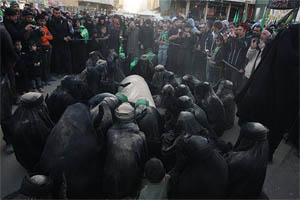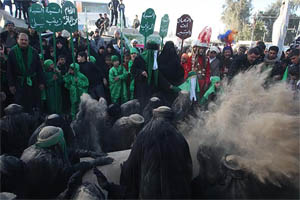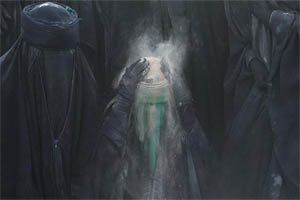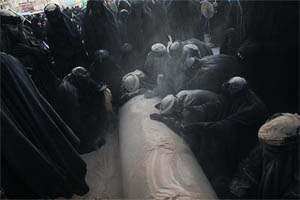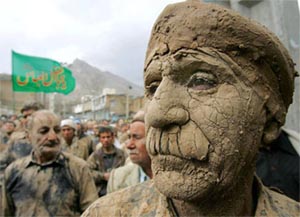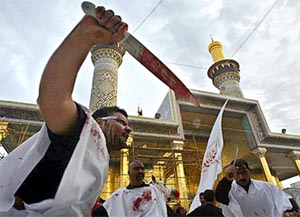Mourning and dancing for the martyrs
Mourning is the most moving aspect of Iranian Shi'ism. This is not an absolutely exclusive feature of this religion. Christianity also celebrates the Passion of Christ and glorifies its martyrs. In Sunni Islam one does not ignore the meaning that human suffering may have; the Sunnis even recognize in Hoseyn, killed at Karbala with his companions by the Umayyad army, an authentic martyr unjustly sacrificed. But the Shiites know more particularly the painful epic of the twelve successors of the Prophet deemed dead as martyrs, and their religious literature attests that, since the highest time, they were crying to receive the battle of their Imams, as invited by the Tradition: "Whoever weeps for or cries for Hoseyn will enter Paradise. "
In Iran, however, religious mourning, the commemoration ceremonies of the Karbala tragedy, is something else ... Like all the Iranian agglomerations, in August 1988, Arâk, a small town in central Iran where Khomeyni began eighteen years of his theological studies, celebrates the days of Tâsu'â and 'Âshurâ , the 9th and 10th of the lunar month of moharram, days when Hoseyn was tortured. Celebrations of great magnitude, with processions of flagellants, lamentations, music(drums, cymbals, fifes and beautiful male voices), behind banners, huge and magnificent insignia or emblems ...
The whole city is boiling! Weeping groups come from each lane and march to the city center to return to their starting point where a meal is served by benefactors. The power of the show is hard to describe: men and women dressed in black, their faces serious, men beating their chests in rhythm, or striking themselves, sometimes strongly, with a small whip chain, apparently without feeling the slightest pain. Several men are walking barefoot, perhaps in accordance with a wish.
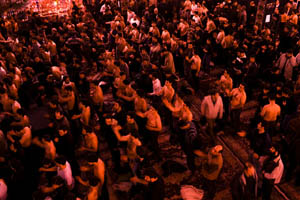 | 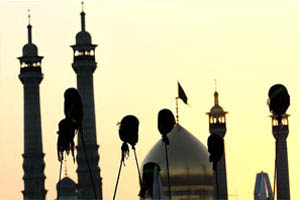 |
| Khomeini Mosque in Tehran | Hussein heads brandished in Qum |
Some participants show heroism, especially those who, in turn, carry the heavy emblems mounted on a metal frame up to four meters wide, decorated with silver figurines (doves, camels), long, soft blades that bow with the wearer's step and decorated with kerosene lamps and precious fabrics. From time to time, before taking up their burial steps, the bearers of emblems stop in front of a group of women sitting in the shadow of a mosque and begin an astonishing and disturbing demonstration of their courage, turning on themselves with their load as if to defy gravity and to dance the most unreal and dangerous ballet that can be imagined: two men stand by their side to ward off the unexpected,
The procession includes only unshaven men and boys, some of whom have donned a sort of shroud to signify their acceptance of martyrdom. Many of the men, on the day of 'Ashurah, were stained with dried mud on the top of their skull and shoulders, a sign that they are preparing to be buried with Hoseyn. Elsewhere, there is evidence of many processions of men who deliberately wounded the skull with a knife to bleed profusely on the face.
Walking slowly under the sun by repeating, when prompted, a slogan or a chorus, they follow the instructions of the cantor who, in a microphone connected to a mobile amplification system, groans to chant his text, which he deciphers in a grimoire and improvises where inspiration permits. If there was one procession, one would think of a carefully organized and executed folk phenomenon. But there are hundreds in this small town.
It's a collective hysteria, a taste of thanatos that has swept the boundaries of all human respect. Where we go, mourning. The radio, the television, the buildings of the public services, everything is rhythmic by this beat, this color, everything is mobilized to manifest the death. The Iranians usually so sober in their collective manifestations, so few men of "representation" so little inclined to the futile spectacles, gather themselves in the hoseyniya to hear the preachers tell them for the hundredth time, for the thousandth time, the death of Hoseyn in Karbala, massacred with his 72 companions by the Umayyad army.
And they cry. They come to cry and they are told what it takes for the tears to flow. They really cry, together, in public, sincerely. They release themselves from the emotion contained elsewhere, where they are so prude and timid. As soon as the preacher's voice begins to shake, the sobs explode, one hits the chest.
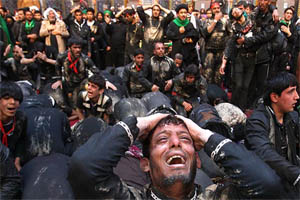 | 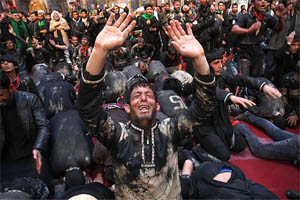 |
Paranoiac Shi'ites crawl, shouting "Labayk Ya Hussein"
|
Elsewhere, in the city, but especially in the villages, there is organized such an exceptional and popular folk theater, ta'ziya . At the same time mystery and celebration, play and tragedy, where the public is all around an outdoor improvised stage (or in the hoseyniya ). The public and the actors are interchangeable: we know Yazid, 'Ali Akbar, Zeynab and Hazrat' Abbas ..., it is those of the village who can read and who are dressed for the occasion of the clothes of the drama. They have their text in hand and the director comes to ask them to read their part by giving them the microphone in their turn.
There's something marvelous about it, with the horses being fired in the middle, the firecrackers exploding during the battle, the hand of 'Abbas flying in the air before he succeeds in taking water in the Euphrates to water the companions of Hoseyn. There is blood, there are shocks of sabers spinning over the heads, there are drumbeats and sobs of death.
This exuberance of mourning and demonstration of morbid heroism is accompanied by a surreal festive climate. Refreshing syrups are distributed everywhere to compensate for the pain of Hoseyn in the arid plain of Karbala. Hearty meals are often given everywhere and often correspond to wishful wishes. We stay in the street late at night: broken with fatigue after having walked the streets the day before 'Ashurah, I hear again, from my bed, after midnight, singers and preachers, cymbals and bass drums; everywhere illuminations burst the night, making mourning forgetful.
The cohesion, the seriousness, the grandeur of these manifestations of 'Ashurâ make me almost afraid. Who would stop the army whose step is a dance, whose leader is that Hoseyn died one thousand three hundred years ago in Mesopotamia? In this collective happening, in this happy and profound grief of Shi'a mourning, there is no shapeless mass obedient to I do not know what agitator, but processions of district, communal groups, parish, in a street or in a bazaar corporation, religious associations proudly inscribe their names on the banner of their procession.
Certainly, we meet in the main street, but each group keeps its own sound, its own pace, its cohesion and finally returns to its own hoseyniya where the kabab, rice and syrup are waiting for it. In the main street, rivalries between neighborhoods, groups and associations can give rise to aggressive attitudes and manifestations of pride that are not compatible with the fusion and self-forgetfulness expected of a unitary demonstration.
The depth of feeling is in no way diminished by splitting. A Sunni Muslim who attends these ceremonies would probably be disgusted with the iramolate debauchery the Iranians are engaged in here. I do not seek to reassure those who are afraid of the collective fusion between religion and the nation, but even if its parish decomposition breaks any hint of political exploitation, the phenomenon is deeper, more complex than a simple mobilization ideological.
Throughout the city of Arak, among the dozens or hundreds of processions that converge towards the city center and then disperse to the neighborhoods from which they came, I see only one molla in dress, a seyyed. Is he aware of the exception he represents? It is well known that Shiite scholars have never favored ostentatious manifestations of mourning in the form of flogging, nor ta'ziya, which is its most elaborate form: they only advocate meetings where clerics -they are the main actors, as preachers, to tell the martyrdom of the holy Imams.
It is therefore a spontaneous ritual, against which neither the police nor the clergy would dare to attempt the slightest movement, but which organizes itself by a solid and unshakable tradition.
Religious feeling, from ritual to myth
The popularity in Iran of the celebrations of Hoseyn's death is an ancient phenomenon. Some authors have not hesitated to bring it closer to a pre-Islamic worship attested by literature - notably in the Book of the Kings of Ferdowsi, a tenth century Persian epic in which are told the founding events of the mythical history of the Iran - and some survivals of this cult are still attested in the provinces of Iran.
It is about the celebration of a hero, Siyavosh , incarnation of perfection, purity and bravery. Unjustly accused by his father's wife whose love advances he had rejected, Siyavosh triumphs out of an ordeal of fire, then, following a brilliant military expedition, he makes a covenant, for the sake of peace, with the enemies. vanquished from the king his father. Renowned by his own, Siyavosh will perish innocent victim of the hatred of men, beheaded by Afrâsyab, a relative of the king who gave him asylum.
"The population of Bukhara," says an old chronicle, "has on the massacre of Siyavosh many lamentations that we know in all the provinces and ministrels have composed songs that the singers call laments of the Magi. "
In the Book of the Kings of Firdousi, Siyavosh presents his torture and gives him an exemplary value:
It will not be long before this wicked and suspicious king makes me die cruelly, despite my innocence. Iran and Turan will be upset and revenge will be such that life will become a burden for men; the whole earth will be filled with misery and the sword of war will reign in the world.
[...] The king of Turan will then repent of what he did and what he said, but this repentance will not benefit him; for all the inhabited earth will be delivered to destruction, cries will be raised from Iran and from Turan, and my blood will cause trouble among men. This is how God wrote it to the firmament and all that sows bears fruit, as he commands ...
Siyavosh makes a dream that he describes to his wife:
My life is not far from its end and the pain of the bitter day approaches. Even if the roof of my palace had risen to Saturn, I should none the less drink the poison of death. Even if my life would have lasted twelve hundred years, I would have in the end for home only the black earth. One finds his tomb in the mouth of the lion, another is devoured by the vulture, a third by the golden eagle; but no man, whatever his knowledge, can convert darkness into light. [...]
This innocent head shall be cut off, and the blood of my heart shall be the crown of it; neither shall I be given a beer, or a burial-place, nor a shroud, and no one among this crowd shall weep over me; I will rest under the earth like a stranger, the head separated from the body by the sword.
Every Iranian, reading this thousand year old text, does not fail to make the connection with the hero of the cause of martyred faith in Karbala. We will also admire the genius of peoples to reinterpret and retranslate in a new symbolic language the intense emotions they feed on to face the trials of fate.
Although the literary texts celebrating the death of Hoseyn abound in the first centuries and emanate from Sunni circles (now casting a critical eye on the Umayyads) that Shi'a, it was not until the advent of the Safavids and the conversion of Iran to Shi'ism from the sixteenth century to public celebrations of the mourning of Hoseyn are organized in Iran.
From the book "The Shi'ite Islam" by Yann Richard
